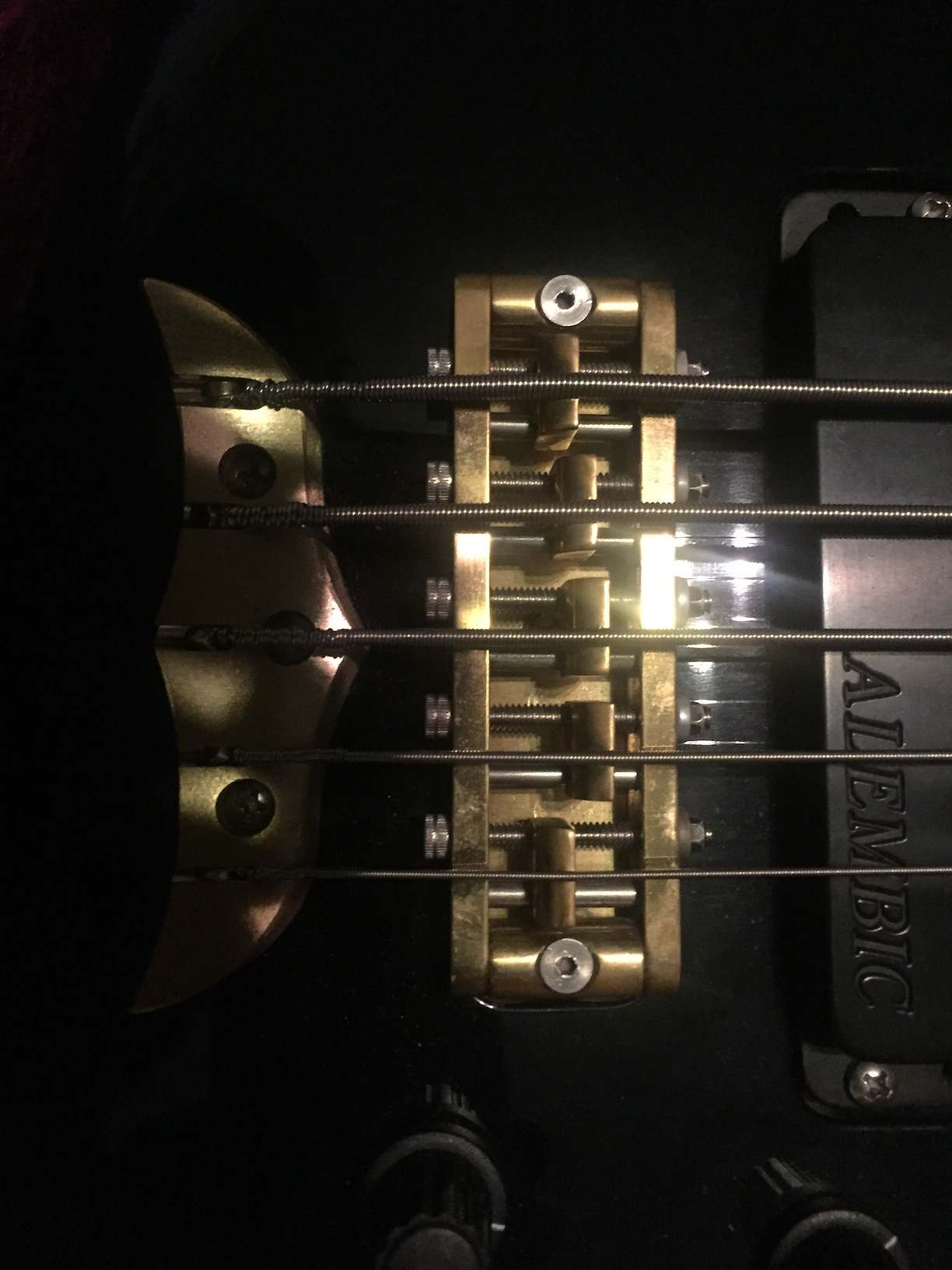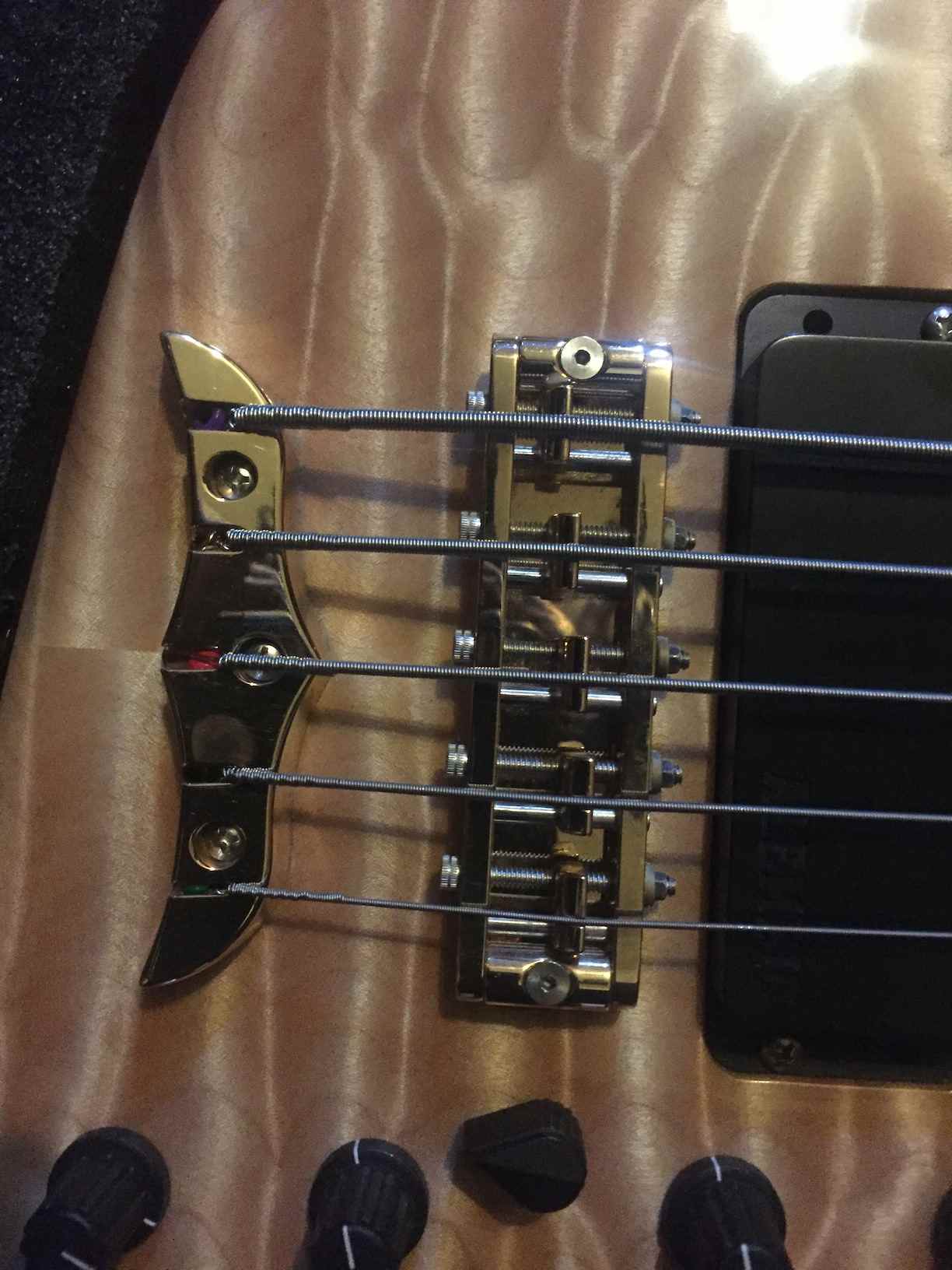| Author | Message | ||
| jazzyvee
Senior Member Username: jazzyvee Post Number: 4842 Registered: 6-2002 |
In all the years I've had alembic's I don't recall having to change the intonation regardless of the strings I put on the bass. Well recently about a couple of months ago I got some elixir coated bass strings 45 -130. I did one gig with them just after they were put on and the last one was last night. Anyway at soundcheck I noticed that the intonation was out, not by much but enough for me to check it with my new tuner and sure enough the G and D strings are a bit off. Anyway after soundcheck I decided to see if I could get it right before showtime and started with the G-string which was slightly sharp so the bridge saddle needed to be moved backwards. But when I moved it and kept testing the intonation hardly changed at all. I was careful to re-tune every thing before checking the harmonic and note at the 12th fret. I moved the saddle back towards the tailpiece about 5mm using the allen key and it hardly made any difference to the intonation. So I put it back where it was previously, did the gig and now want to get everything adjusted properly before the next gig. Am I going wrong somewhere? The only think I wondered afterwards was if I should have removed/loosened the nut holding the saddle adjustment screw first and also should I slacken off the string before adjusting the saddle position. Thanks | ||
| smokin_dave
Senior Member Username: smokin_dave Post Number: 443 Registered: 10-2002 |
Using a strobe tuner always worked best for me.In the past I ran into the same thing and used a friends Strobe tuner as opposed to the chromatic tuner I was using.The Strobe did the trick. | ||
| jazzyvee
Senior Member Username: jazzyvee Post Number: 4844 Registered: 6-2002 |
With respect smokin_dave, I appreciate that the strobe tuner may well be the most accurate but firstly I need to determine the correct method of adjusting the alembic bridge which is primarily what I'm trying to establish. As it stands, I don't have a strobe tuner so whatever the answer is to the above I will have to make do with what I have currently which is a boss TU3 pedal tuner and a TC Electronics Polytune clip. I previously owned a peterson strobostomp tuner but there was a fault with it and i returned it for a refund. Thanks for chipping in. :-) | ||
| smokin_dave
Senior Member Username: smokin_dave Post Number: 444 Registered: 10-2002 |
Hey Jazzy.This a great thread on correctly setting intonation. http://alembic.com/club/messages/393/20353.html?1124583910 Using new strings and slightly detuning the string for saddle adjustments seems to be the way to go. Mod.Dave uses the 5th fret harmonic and fretted 24th fret method. | ||
| jazzyvee
Senior Member Username: jazzyvee Post Number: 4845 Registered: 6-2002 |
Thanks Dave, I read that thread but I didn't find anything about whether you should unscrew the saddle bolt so I wasn't sure enough to proceed. Anyway I managed to get hold of John Prock ( a former alembic employee) on Facebook and he told me I was doing things correctly so I've continued with that approach and now the intonation is ok. Thanks | ||
| bigredbass
Senior Member Username: bigredbass Post Number: 2528 Registered: 9-2002 |
Jazzy: In my experience, Brand A 45-130 intonates differently than Brand B 45-130 intonates differently than Brand C 45-130. In other words, Replace, say Roto SwingBass 45-130's with any other brand's roundwound 45-130 and you're going to need to re-tune your saddle lengths, albeit probably only slightly. This is because the construction (type/size core, gauges of the how many external windings, etc.) are going to vary from brand to brand. So even though the sizes are the same, they are two different things. Also, tuned to 'working' pitch, sometimes, some saddles will 'drag' the windings with them, so you sometimes have to de-tune to allow free movement as you turn the screw/move the saddle, then re-tune once you've broken that 'sticky set' the string took. Never used them, but I could see that 'sheath' that those Elixirs are covered in doing this. Joey | ||
| bigredbass
Senior Member Username: bigredbass Post Number: 2529 Registered: 9-2002 |
Jazzy: In my experience, Brand A 45-130 intonates differently than Brand B 45-130 intonates differently than Brand C 45-130. In other words, Replace, say Roto SwingBass 45-130's with any other brand's roundwound 45-130 and you're going to need to re-tune your saddle lengths, albeit probably only slightly. This is because the construction (type/size core, gauges of the how many external windings, etc.) are going to vary from brand to brand. So even though the sizes are the same, they are two different things. Also, tuned to 'working' pitch, sometimes, some saddles will 'drag' the windings with them, so you sometimes have to de-tune to allow free movement as you turn the screw/move the saddle, then re-tune once you've broken that 'sticky set' the string took. Never used them, but I could see that 'sheath' that those Elixirs are covered in doing this. Joey | ||
| lbpesq
Senior Member Username: lbpesq Post Number: 6316 Registered: 7-2004 |
I always de-tune a lot, basically allow the string to be almost slack, then adjust the bridge piece either forward or backward, as appropriate, and then re-tune and check the intonation. I never adjust intonation while the string is taut. Bill, tgo | ||
| ed_zeppelin
Advanced Member Username: ed_zeppelin Post Number: 220 Registered: 2-2010 |
I'll repost David Fung's brilliant post about tuning, because he is far more eloquent and knowlegible than I:
| ||
| jazzyvee
Senior Member Username: jazzyvee Post Number: 4846 Registered: 6-2002 |
Ok all is well an the bass is in tune with itself. The G saddle on the first picture is the one that needed correction. The saddle was just about where it shows in the second picture before I adjusted the intonation. I'm surprised the difference is that great. This one has been adjusted for the new Elixir strings.  This is another bass with D'addario Pro steel strings.  Anyway its sounding fine now so I guess all is well. Sorry for the large pics, Even though I reduce the image size and file size they often sill end up looking big. (Message edited by jazzyvee on January 02, 2016) |